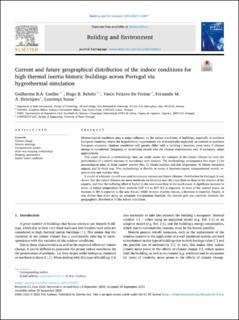| dc.contributor.author | Coelho, Guilherme Barreto Arez | |
| dc.contributor.author | Rebelo, Hugo B. | |
| dc.contributor.author | de Freitas, Vasco Peixoto | |
| dc.contributor.author | Henriques, Fernando M.A. | |
| dc.contributor.author | Sousa, Lourenço | |
| dc.date.accessioned | 2023-11-23T07:31:39Z | |
| dc.date.available | 2023-11-23T07:31:39Z | |
| dc.date.created | 2023-09-26T20:57:35Z | |
| dc.date.issued | 2023 | |
| dc.identifier.citation | Building and Environment. 2023, 245 . | en_US |
| dc.identifier.issn | 0360-1323 | |
| dc.identifier.uri | https://hdl.handle.net/11250/3104218 | |
| dc.description.abstract | Meteorological conditions play a major influence on the indoor conditions of buildings, especially in southern European countries, where the hygrothermal requirements are systematically neglected, on contrast to northern European countries. Outdoor conditions will greatly differ with a building’s location, even more if climate change is considered. Designing or retrofitting should take the climate requirements and, if necessary, adapt appropriately. This paper presents a methodology that can easily assess the variance of the indoor climate or even the performance of a retrofit measure in accordance with location. The methodology encompasses five steps: 1) Set meteorological data; 2) Build outdoor weather files; 3) Obtain interface soil/slab temperature; 4) Obtain simulation outputs; and 5) Build map. This methodology is flexible in terms of location/region, computational model, requirements and weather data. A model of a historic church was used to compute current and future climates’ distribution for Portugal. It was shown that the indoor climates are more moderate on locations near the coast than on those in the interior of the country, and that the buffering effect is higher in the west coast than in the south coast. A significant increase in terms of indoor temperature from scenario RCP 4.5 to RCP 8.5 is expected. In most of the coastal zones, an increase in RH is expected in the near future, whilst in some interior regions, a decrease is expected. Finally, it was shown that when using an adequate interpolation function, the coarser grid can correctly simulate the geographical distribution of the indoor conditions. | en_US |
| dc.language.iso | eng | en_US |
| dc.rights | Navngivelse 4.0 Internasjonal | * |
| dc.rights.uri | http://creativecommons.org/licenses/by/4.0/deed.no | * |
| dc.title | Current and future geographical distribution of the indoor conditions for high thermal inertia historic buildings across Portugal via hygrothermal simulation | en_US |
| dc.type | Peer reviewed | en_US |
| dc.type | Journal article | en_US |
| dc.description.version | publishedVersion | en_US |
| cristin.ispublished | true | |
| cristin.fulltext | original | |
| cristin.qualitycode | 2 | |
| dc.identifier.doi | 10.1016/j.buildenv.2023.110877 | |
| dc.identifier.cristin | 2179176 | |
| dc.source.journal | Building and Environment | en_US |
| dc.source.volume | 245 | en_US |
| dc.source.pagenumber | 17 | en_US |

